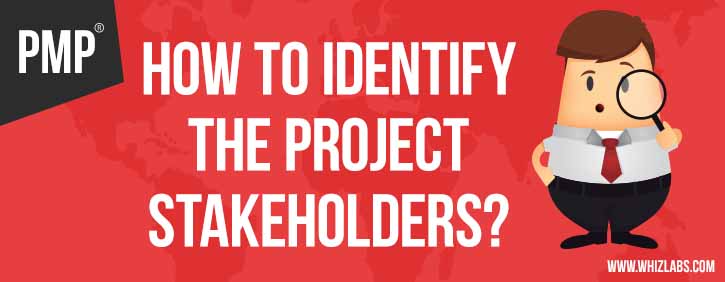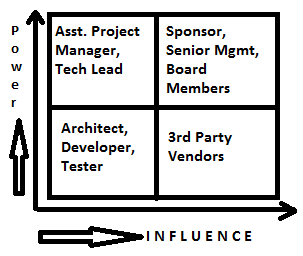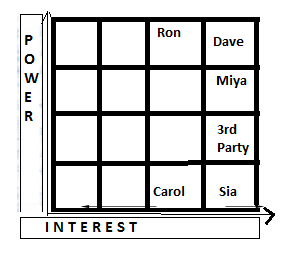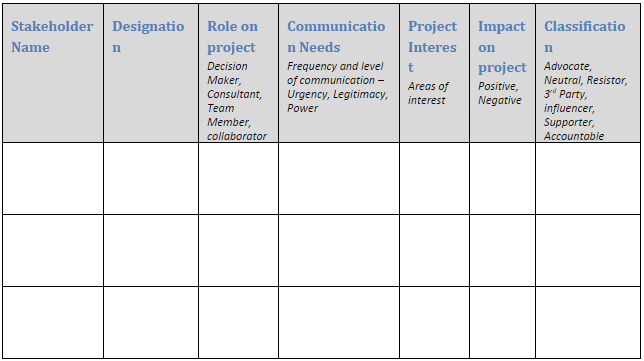We are publishing series of articles on PMP topics to help the PMP exam preparation. In this article we are going to explain you how to identify the project stakeholders.
- TRY NOW : 50 PMP Practice Questions
- Access our 487 mins Self-Study Training (Get 35 contact hours certificate)
So, here we are trying to initiate our project and we have received the formal authority in the form of Project Charter. But a project cannot begin unless we have identified who our stakeholders are. Identifying the Stakeholders in the beginning of the project is so important to the success of a project that PMP has a process named ‘Identifying Stakeholders’ right in the beginning, as a part of its ‘Initiating process group’ (one of the 5 process groups of PMP) .
If we believe we are doing everything right and yet our stakeholders seem unhappy, we cannot call the project a success. A true quality of a leader is to consider every Stakeholder as an integral part of the project and therefore, should not shy away from any opportunity to influence anyone. But to achieve that we must first know, who our Stakeholders are? Or who really are called Stakeholders for that matter?
To define in terms of PMBOK 5th Edition, Stakeholder is an individual, a group, or an organization who may affect, be affected by, or perceive it-self to be affected by a decision, an activity or an outcome of a project (Std. Def).
So, clearly Stakeholder includes everyone, i.e., people who are affected by our project, or who can influence our project, or have expectations from our project. So by the definition, a Stakeholder is not necessarily the sponsor or board member only, it can also be a team member or the project manager himself. When a project begins, it starts impacting each and everyone associated with the project, be it higher on the hierarchy or lower. Everyone associated becomes a Stakeholder.
How to identify the Stakeholders?
So how do we go about identifying the Stakeholders, and if everyone is a Stakeholder do we need to treat them all on same scale? This is what the process of identifying the Stakeholders, addresses:
- How to source the information on stakeholders?
- How to act on the information on stakeholders?
- How to document the information on Stakeholders?
Inputs
- Project Charter – Project Charter not only documents the formal authority for the Project Manager, it also lists the Key Stakeholders that comprises of the Sponsor, Senior Management, or consulting management. The charter also becomes the source to Procurement and Contract related stakeholder information, if the project needs to outsource work, services or product.
- Procurement Documents – In addition to the Charter, the other procurement documents also act as a great source to third party stakeholders, who may not be key stakeholders but do fall lower in the hierarchy.
- Enterprise Environmental factors (EEF) – We all know that EEF indicates how the regulations, standards and compliance, market status, human resource capabilities and organizational structure, etc. affects the project. The organizational structure becomes a key input from EEF, to Identifying key stakeholders on the hierarchical basis. It gives us an insight to who has the most power to influence the project.
- Organizational Process Assets (OPA) – OPA is the repository that keeps project documentations from past projects, Lessons learned from past projects, templates of forms/reports and other documentation, intranet sites information, procedures, policies and standards all in one place as a reference for every other project being carried out in the organization. We could use Stake holder register template as well as Stakeholder analysis data from past projects to ensure we are on the right track.
Tools and Techniques
- Stakeholder Analysis – As it sounds literally, analyzing all the information gathered from the inputs of Identifying Stakeholder will help us in understanding which stakeholder can positively influence the project and which one can negatively influence it. So we must start recording the role of each individual, their area of interests, their level of influence and their expectations, against the list of all stakeholders. We could use the interviewing technique to identify expectations and interests of all listed stakeholders in detail. This could also reveal more stakeholders. Also, we could handle on our stakeholders’ concerns and start making plans to addressing them. That’s how we turn a negative stakeholder into a positive one.
Once we have the details in hand we could use the recorded details to classify stakeholders into various categories depending on their support, influence, interests, and power. It’s useful to group stakeholders together, because stakeholders in a particular group are likely to have similar needs and interests.
One of the best and most popular way to do it is come up with consolidated representation of our stakeholders is a 2 variable Grid view. These grids are generally termed as Power/Interest Grid or Power Influence Grid or Power/Support Grid, any or all of them depending on the size and volume of the project, team and stakeholders.
When we are analyzing for Support, we could use Resistor, Neutral and Advocate as the groups to categorize stakeholders:
- Resistor – A negative stakeholder who is actively and vocally not supporting the project
- Neutral – A stakeholder who does not support, yet do not actively oppose to the project. A project manager will always try to convert their interests and turn them positive.
- Advocate – A stakeholder who openly and aggressively supports the project and is vocal about it. Provides ideas to improvise all circumstances.
The PMBOK 5th Edition guide classifies the analysis in 4 models:
- Power/Influence Grid (Discussed above)
- Power/Interest Grid (Discussed above)
- Influence/Impact Grid (Discussed above)
- Salience Model – The Salience model indicates the level for the need of attention by the stakeholders. It uses 3 variables unlike the other 2 variable grids. The 3 variables it uses are Power/Urgency/Legitimacy.
A simple sample of what a 2X2 Power/Influence grid would look like is given below in diagram 1.0. In a real list, the grid will be larger with more data and stakeholder information within each cell. Every cell could have more than one stakeholder details, based on their power to influence.
The next diagram is a 4X4 grid showing a sample of Power/Interest Grid.
- Expert judgment – Expert Judgment is based upon the inputs from expertise of certain individuals, which could be from specialized education, knowledge & research, skill, experience, or training.
- Meetings – Meetings help us facilitate gathering and comparing information from different stakeholders. It also becomes a good platform for brainstorming ideas, interviewing stakeholders and identifying threats to a project. In addition, this uncovers who is vouching for your project and who is being unsupportive; in other words it’s also way to figure out the positive and the negative stakeholders.
Output
- Stakeholder Register – All the information that we gathered through Stakeholder analysis and all the representations that we came up with, helps us in creating Stakeholder Register. A register compiles all the information in a tabular format in general. However, if the project is an extremely large-scale, containing everything in one table is not a mandate.
A project manager must be sure to identify and list all potential stakeholders in the Stakeholder Register in order to facilitate project success. A Stakeholder Register may be used to record high level information of each stakeholder and their planned/forecasted role on the project. An example of a potential structure of a stakeholder register is depicted below in table 1.0.
- Stakeholder Management Strategy – As the name suggests, stakeholder management strategy is documented to plan and strategize the actions and response to be taken towards each stakeholder during the whole course of the project management. It also includes our communication strategy for key stakeholders and otherwise. The strategy is a documented approach to minimizing the negative influences on the project.
The stakeholder management strategy document includes the following as per PMBOK 5th edition guide:
- Key Stakeholder’s impact on the project
- Stakeholders’ level of participation as per stakeholder analysis
- Groups designated to each stakeholder
- Assessment of Impact
- Potential strategy for gathering Support
Practice Questions
1. What Process Group does the Identifying Stakeholders fall in?
- Planning Process Group
- Closing Process Group
- Initiating Process Group
- Develop Project Charter
Answer. C.
2. How many factors/variables is Salient Model of establishing stakeholder level of power and interests, based on?
- n variables
- 2 variables
- 3 variables
- 4 variables
Answer. C.
Summary
- TRY NOW : 50 PMP Practice Questions
- Access our 487 mins Self-Study Training (Get 35 contact hours certificate)
In this article we have explained about how to identify the project stakeholders and the stakeholders register. If you have any questions, please write it in the comments section.
- Top 20 Questions To Prepare For Certified Kubernetes Administrator Exam - August 16, 2024
- 10 AWS Services to Master for the AWS Developer Associate Exam - August 14, 2024
- Exam Tips for AWS Machine Learning Specialty Certification - August 7, 2024
- Best 15+ AWS Developer Associate hands-on labs in 2024 - July 24, 2024
- Containers vs Virtual Machines: Differences You Should Know - June 24, 2024
- Databricks Launched World’s Most Capable Large Language Model (LLM) - April 26, 2024
- What are the storage options available in Microsoft Azure? - March 14, 2024
- User’s Guide to Getting Started with Google Kubernetes Engine - March 1, 2024



